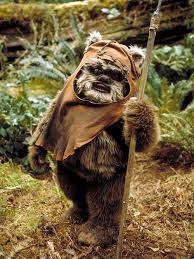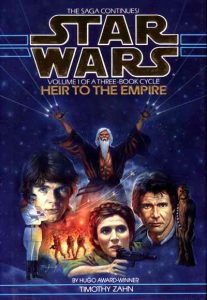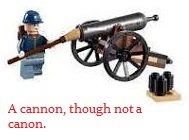Stars Wars is so much more than a mere movie. Merchandise seems to range as far as lightsaber lint brushes, to Millennium Falcon aluminum foil. You can’t swing a Wookie without hitting a Hutt whenever new movies come out. For a brief time in the 90s however, Star Wars thrived primarily in the world of novels. These novels stoked so much interest during the decade that they even deserve some credit for helping bring about the prequel movies—just don’tch you-sa blame them for Jar-Jar.
George Lucas created Star Wars for the screen, but he also created his movie at a time when blockbusters commonly got novelizations. Star Wars, the novel, was released in December of 1976, six months before the movie. The book was credited to George Lucas, though was actually written by Alan Dean Foster, who of course, got the story from Lucas. Foster also signed a contract to write a second Star Wars book. The second book was based off an idea Lucas had for a low-budget sequel, and served as a backup plan in the case that the first film flopped and 20th Century Fox pulled their heavy funding.
 Splinter of the Mind’s Eye was released in 1978. Though the novel wasn’t recognized as genuine events between movies, sales of the book showed that fans clamored for more of the Star Wars universe, and not the kind of supplemental stuff that comes in the form of holiday TV specials. A Han Solo book trilogy would be released over the next two years. In 1983, Lando Calrissian got his own trilogy of books too. Lucas rightfully protected his own creative work, and none of the books, or the comic books of the era, were allowed to interfere with the developing storyline of the movie trilogy.
Splinter of the Mind’s Eye was released in 1978. Though the novel wasn’t recognized as genuine events between movies, sales of the book showed that fans clamored for more of the Star Wars universe, and not the kind of supplemental stuff that comes in the form of holiday TV specials. A Han Solo book trilogy would be released over the next two years. In 1983, Lando Calrissian got his own trilogy of books too. Lucas rightfully protected his own creative work, and none of the books, or the comic books of the era, were allowed to interfere with the developing storyline of the movie trilogy.
After 1983 and the release of Return of the Jedi, Star Wars popularity echoed for a while . There were comic books, and lots of children’s books. The mid-80s saw two different cartoon series, one featuring Ewoks, the other, Droids. The Ewok’s got two live-action TV movies, and though these are a far cry from a Star Wars movie, fans of bad-ass teddy bears will love them. Over time, the ripple from the movies began to fade and Star Wars, believe it or not, even somewhat subsided from mainstream pop culture.
. There were comic books, and lots of children’s books. The mid-80s saw two different cartoon series, one featuring Ewoks, the other, Droids. The Ewok’s got two live-action TV movies, and though these are a far cry from a Star Wars movie, fans of bad-ass teddy bears will love them. Over time, the ripple from the movies began to fade and Star Wars, believe it or not, even somewhat subsided from mainstream pop culture.
In the late 80s, LucasArts wanted to pursue the idea of expanding the Star Wars universe further. The company surely saw room for potential. George Lucas claimed he wanted to someday pursue a prequel trilogy, but the the company had probably grown tired of waiting. So LucasArts sought out an author to create a new story that would take pla ce three to five years after the events in Return of the Jedi. The company found Timothy Zahn. George Lucas read and approved of Zahn’s forthcoming story. In 1991, Heir to the Empire released, and was so successful, it reached number one on the New York Times bestseller list. Zahn created his own sequel trilogy over the next few years, and he deserves credit for helping to open the floodgates. In 1992, four Star Wars novels were published. By 1995, the number reached ten novel publications.
ce three to five years after the events in Return of the Jedi. The company found Timothy Zahn. George Lucas read and approved of Zahn’s forthcoming story. In 1991, Heir to the Empire released, and was so successful, it reached number one on the New York Times bestseller list. Zahn created his own sequel trilogy over the next few years, and he deserves credit for helping to open the floodgates. In 1992, four Star Wars novels were published. By 1995, the number reached ten novel publications.
Significant about all these novels, Lucas Arts oversaw the project. The novels were set in an interconnected world. Authors chose different timelines to develop, not always going in a sequential order, but developing the timeline after Return of the Jedi, or even the time periods between movies. George Lucas even occasionally gave suggestive input, and he, as the artist who had created the original story, was hailed and thanked by both authors and fans.
Because of the coexistence between LucasArts, the authors, and George Lucas, the ongoing novels came to be seen as established canon. Of course, canon is one of those words people throw around a lot. The word historically applied to the bible and stuff the church saw as legitimate writing. The situation around the Star Wars novels seemed nothing but legitimate, and this legitimacy was one of the coolest things about reading these novels in the 90s. Fans got to see their favorite characters in new storylines, got brand new adventures, and as sales of the books continued to fund LucasArts, the relationship seemed to benefit everyone: authors, company, fans. But, just like a princess trying to cruise through space on a diplomatic mission, this peace could not continue to last.
established canon. Of course, canon is one of those words people throw around a lot. The word historically applied to the bible and stuff the church saw as legitimate writing. The situation around the Star Wars novels seemed nothing but legitimate, and this legitimacy was one of the coolest things about reading these novels in the 90s. Fans got to see their favorite characters in new storylines, got brand new adventures, and as sales of the books continued to fund LucasArts, the relationship seemed to benefit everyone: authors, company, fans. But, just like a princess trying to cruise through space on a diplomatic mission, this peace could not continue to last.
Check out part 2 of my look at 90’s Star Wars novels and how the release of the prequel movies changed the literary landscape of the galaxy far, far away.
2 Replies to “M.Y.O.P.I.A. # 15: Star Wars: Episode I – The Canon Awakens”
Comments are closed.